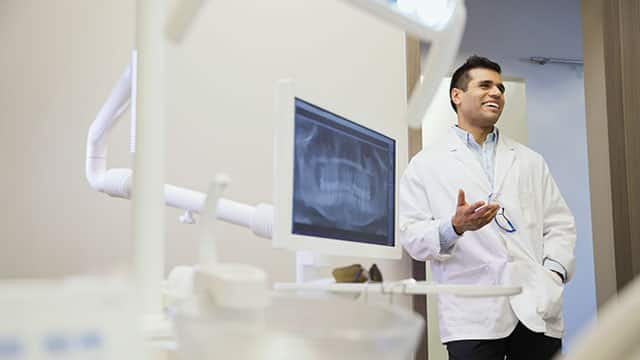-
-

FLUORIDE
What Is Stannous Fluoride Toothpaste?Discover what is Stannous Fluoride Toothpaste and its importance to prevent cavities and other oral health problems.

TEETH WHITENING
Whitening toothpaste - hydrogen peroxide vs. carbamide peroxideIf you lose one or more of your front teeth due to injury or decay, you may feel ...
-
Science & InnovationOral Health Commitment
- Oral Health Commitment
- Bright Smiles, Bright Futures
- Educational Resources
- Mobile Dental Van
- Volunteer
- ORAL HEALTH CHECK
- PRODUCT MATCH
- Oral Health and Dental Care | Colgate®
- Oral Health
- What Is Condensing Osteitis?


While it's a tricky term to pronounce, to stay the least, Condensing Osteitis is quite simple when identified to diagnose and treat. Instead of making the bone smaller — condensing osteitis actually produces more bone density, specifically at the base of a tooth's root. This usually crops up due to an infection and chronic inflammation in the dental pulp, or the interior part of your tooth. It’s quite possible that you won’t feel or see any symptoms, but you should still make sure your dentist keeps an eye on it should treatment be necessary.
How Condensing Osteitis develops
Your commons sense would tell you that inflammation from an infected or dead nerve in your tooth would make it smaller. However, condensing osteitis actually spurs bone growth in your jawbone. It doesn't destroy it but instead increases bone density while decreases space for bone marrow — typically affecting your lower back molars. According to a study from Brazilian Oral Research, the age range for condensing osteitis is quite broad, spanning from 30-70 years of age. Fortunately, most people diagnosed with it don't experience any pain or symptoms.
How To diagnosis Condensing Osteitis
It's slightly peculiar, but since condensing osteitis symptoms are often not present, most diagnoses aren't made until you see your dentist. It's there during a regular dental checkup while receiving a routine X-ray, the pulp of your tooth is examined. The bone growth looks opaque under your root within the X-ray — whereas bone destruction would appear transparent, accompanied by pain and discomfort. Condensing osteitis is relatively uncommon. It consists of only 2% of conditions diagnosed during a routine X-ray exam, according to a study published in Dentomaxillofacial Radiology. The use of diagnostic x-ray equipment allows your dental professional to assess the bony area without a biopsy properly. All this makes it all the more important to maintain your regular dental exams and X-rays so your dentist and dental hygienist can identify any potential issues.
What's the treatment for Condensing Osteitis?
Once your dentist has diagnosed you with condensing osteitis, there are a few solutions when it comes to treatment options—some more invasive than others.
- Monitor the increased bone density while there are no current symptoms
- Treat the affected tooth with either endodontics, a different restoration, or tooth extraction.
- Have your dentist perform a root canal procedure to treat the infected tooth
- See an endodontist, a root canal specialist, to perform the procedure
- Work with your dentist or endodontist post-procedure on keeping your tooth healthy in the future
There are some incidents with oral health, like condensing osteitis, that happens, and there's nothing you can do. However, what you can do is brush, floss, and get dental checkups with X-rays regularly. If you do that, your dentist, thankfully, can diagnose and treat any potential dental issues you may have.
Oral Care Center articles are reviewed by an oral health medical professional. This information is for educational purposes only. This content is not intended to be a substitute for professional medical advice, diagnosis or treatment. Always seek the advice of your dentist, physician or other qualified healthcare provider.
Related Articles

Root canals
What Is Pulp Capping?What is pulp capping and why may your dentist recommend a cap for you or your child? Learn more, here.

Root canals
Ferrule Effect: What Is It?Teeth or crowns may flex or move. This movement can lead to fracture. The ferrule effect helps reduce the risk of the tooth fracturing, though it doesn't guarantee it.

Root canals
Pulpotomy In AdultsA pulpotomy is a procedure a dentist may use to preserve your tooth when portions of a tooth's pulp is injured. Learn more, here.

Root canals
Antibiotic Prophylaxis Before Dental WorkBefore you undergo dental treatment, your dentist or medical provider may recommend antibiotic prophylaxis. Learn what it is and how it works.
Related Products

Esse enxaguante bucal multibenefício Colgate Total 12 Carvão Ativado apoia as defesas naturais da sua boca com o zinco. Ele também ajuda a manter os dentes mais brancos, além de combater germes e bactérias para uma limpeza total por até 12 horas.

Colgate Total Alcohol Free* Gum Health Mouthwash delivers 24-hour protection** against bacteria and also helps prevent gum problems

Colgate Total Fresh Mint Toothpaste fights bacteria, the root cause of many oral health issues such as gingivitis, tartar, sensitivity, weak enamel, bad breath, and cavities.

Formulated with Fluoride and with a great mint taste, Colgate Cavity Protection Toothpaste cleans thoroughly, strengthens teeth, and fights cavities.

Helping dental professionals
More professionals across the world trust Colgate. Find resources, products, and information to give your patients a healthier future




